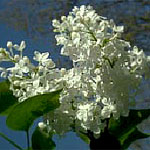Egolf & Pooler, 1992
‘Betsy Ross’, S.
Egolf & Pooler 1992; S I
syn. – NA 62973, PI 596517
{? × S. oblata NA 36751, PI 391403, coll. in China in 1974}
USDA-ARS Notice of Release [July 21, 2000]; American Nurseryman 192(12):46 [2000]; USNA Pl Introduction [Aug. 2000]; Vrugtman, HortScience 37(7):1145 [2002]; Pooler, HortScience 43(2):544–545 [2008]; Photo on Jorgovani/Lilacs 2015 DVD.
Named for Betsy Ross, née Elizabeth Griscom, 1752-1836, a flag maker, who may have sewed the first American flag.
nomenclatural standard deposited at United States National Arboretum Herbarium
(NA); NA-0035725; Hanburyana 4:56 [2009].
cultivar name registered 2001; name established and accepted.
Международный регистр названий культиваров рода Syringa L.
Syringa L. ‘Betsy Ross’ was registered August 25, 2001, by Margaret R. Pooler, United States National Arboretum, 3501 New York Avenue, NE, Washington, D.C. 20002-1958, USA.
The original plant (NA 62973, PI 596517) was originated in 1977 and selected in 1984 by the late Donald Egolf at the US National Arboretum; it resulted from a cross using Syringa oblata Lindl. (NA 36751, PI 391403), collected in 1974 in China, as the male parent, and an unidentified Syringa species from Highland Park, Rochester, N.Y., as the female parent. Plants were first distributed for evaluation in 1992. The selection was named in June 2000. Jerry Blankenship suggested to name the new lilac for Betsy Ross, née Elizabeth Griscom, 1752-1836, who sewed the first American flag. Syringa ‘Betsy Ross’ was selected for its abundant pure white fragrant flowers, relatively compact rounded growth habit, disease tolerant foliage, and adaptation to warmer climates. It is a rounded, moderately-sized shrub that has grown three meters high and four meters wide in 16 years; it is hardy in USDA zones 5-7. Thyrses to 35 cm long and 15 cm across. Florets single, to 1.7 cm in diameter, white; fragrant. The cultivar name and partial description appeared in American Nurseryman 192(12):46, December 15, 2000. A standard portfolio has been opened at Royal Botanical Gardens Herbarium, Hamilton, Ontario, Canada, but is still incomplete.
Lilac Registration 2001. Freek Vrugtman, Royal Botanical Gardens, Hamilton, Ontario, Canada
The U.S. National Arboretum announces the release of ‘Betsy Ross’, a lilac cultivar developed specifically for warmer climates. Adorned with a fluffy coverlet of blooms in early spring, ‘Betsy Ross’ charms and delights the senses with pure white flowers of simple beauty and pleasing fragrance, recalling those halcyon days when “lilacs last in the dooryard bloomed…”
Syringa ‘Betsy Ross’
(NA 62973; PI 596517)
Oleaceae
U.S.D.A. Zones (4) 5–8
‘Betsy Ross’ is the product of a lilac hybridization program initiated in the early 1970’s by the late Dr. Donald Egolf to develop superior, disease-tolerant lilacs for warmer climates. ‘Betsy Ross’ originated from a cross made in 1977 using Syringa oblata collected in China as the male parent and an unidentified Syringa from Highland Park, Rochester, NY, as the female parent. ‘Betsy Ross’ has been evaluated in a wide range of climatic areas from Minnesota to Alabama and west to California and Oregon. It was named and released by Dr. Margaret Pooler in July, 2000.
‘Betsy Ross’ is the first lilac cultivar to be released by the U.S. National Arboretum. Selected for its abundant, white, fragrant flowers and rounded growth habit, it is well adapted to warmer climates and has good field tolerance to powdery mildew.
Height and width: 9.75 feet tall and 13 feet wide at 16 years.
Habit: Deciduous, multistemmed, relatively compact, rounded shrub.
Foliage: Thick, dark green leaves, field tolerant to powdery mildew.
Flowers: Abundant inflorescences of large, white, fragrant flowers completely covering the plant in early April.
Fruit: A leathery capsule; not showy.
Grows well in any moderately fertile, well-drained soil in open, sunny sites (full sun for at least two-thirds of the day) with good air circulation. A soil pH of 6.0–7.5 is recommended. Avoid planting in frost pockets or against warm buildings that would prematurely force flower buds.
Roots fairly easily from semi-hardwood cuttings taken after flowering while the tips are still growing. Rooting occurs in 6–8 weeks under mist, 3000–5000 ppm IBA. Suitable for commercial propagation by grafting or micropropagation.
Early-blooming focal point in a mixed shrub border; single specimen; massed group; deciduous hedge or screen.
Available in retail nurseries in 2002–2003.
Еще более подробно об этом сорте можно почитать в статье Маргарет Пулер на сайте American Society for Horticultural Science


Оставить комментарий
Пожалуйста, зарегистрируйтесь, чтобы иметь возможность оставлять комментарии.